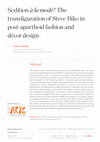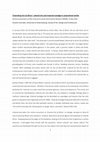Papers by Annemi Conradie

Tydskrif vir Letterkunde, 2023
In post-apartheid South Africa, the representation of queer identities in Afrikaans-language film... more In post-apartheid South Africa, the representation of queer identities in Afrikaans-language films have become increasingly prominent. However, many such films focus on past contexts or serve as comedic depictions, failing to confront the complex issues faced by individuals in contemporary Afrikaner communities. Etienne Kallos’s 2018 coming-of-age film Die stropers (The Harvesters) candidly depicts the challenges faced by adoptive brothers Janno and Pieter, who must negotiate desire and gender in a conservative, Afrikaans farming community. Drawing on Judith Butler’s notion of gender performativity and recent reformulations of Raewyn Connell’s notion of hegemonic masculinity, we examine the discursive (re)production of hegemonic Afrikaner masculinity within the boys’ adoptive family and community. We investigate how the protagonists strategically deploy performative masculinities to achieve belonging and acceptance as heirs, even if the ideals they emulate oppress and restrict them. We propose that the protagonists’ strategic deployment of performative masculinities represents their claiming of agency in contexts where gender and desire are aggressively policed. Furthermore, their navigation of hegemony in this white, Afrikaner community through resistance and consent might point to a claiming of space for queer identities and the continued transmutation of hegemonic masculinity.
OPEN ACCESS: DOWNLOAD PAPER FROM https://letterkunde.africa/article/view/14099.

Image & Text , 2020
The portrait of slain anti-apartheid revolutionary, Steve Bantu Biko, has been variously transfig... more The portrait of slain anti-apartheid revolutionary, Steve Bantu Biko, has been variously transfigured and commodified in political and consumer discourse since his death in 1977. This process is evident in the reproduction of Biko's por trait on garments and décor accessories. At the time of his death, a commemorative T-shirt hastily printed for his funeral was promptly banned. Three decades later, images of Biko's face adorned tank tops and cushion covers displayed in trendy, upmarket boutiques. The focus in this ar ticle is the appropriation and reproduction of Biko's portraits in a selection of South African fashion and décor designs. I ask whether the images of radical political figures are necessarily domesticated or denuded of subversive power once rendered and consumed as fashionable, retro accessories. If invoking Biko's name, as Ahmed Veriava and Prishani Naidoo (2008:234) suggest, is to invoke a legacy of struggle and sedition, what new meanings arise when historic signifiers of this icon are consumed as retro fashions? These questions are explored within the context where Biko's work and image are given new prominence by young black activists who were born in a democratic South Africa, but are not yet enjoying the freedoms that Biko's generation fought and died for.

Mode of Mutuality: Io Makandal's 'Life in the entropics' , 2019
'Life in the Entropics' is Io Makandal's second solo exhibition at Kalashnikovv Gallery. The show... more 'Life in the Entropics' is Io Makandal's second solo exhibition at Kalashnikovv Gallery. The show's title points to existence in times and spaces that are marked by entropy, which describes inevitable changes within a closed system, usually from a state of order to a state of disorder and unpredictability. In her first solo exhibition at Kalashnikov Gallery in 2017, titled 'Entropy into a third landscape', Makandal juxtaposed urban debris and consumer goods with hanging and protruding plants, suggesting nature's potential to reclaim its ground. In 'Life in the Entropics', the leafy greens are strikingly absent, as if they have retreated or been eradicated. Despite human efforts to minimise disorder, to systematise and optimise productivity and profit, the entropy within a system-such as the universe-is inevitably intensifying. For mathematician James Newman, "entropy is the general trend of the universe toward death and disorder". As such, 'Life in the Entropics' exploits the dichotomies of order and disorder, transformation and ruin inherent to the processes of entropy but without becoming fatalistic. In fact, allowing oneself to be immersed in one of Makandal's drawings, is to be hurled into vast worlds of vibrating, pulsating life. Irrespective of our
ArtThrob , 2019
Robert Slingsby's exhibition In/Dependence offers a continued visual expression of the artist's e... more Robert Slingsby's exhibition In/Dependence offers a continued visual expression of the artist's enduring fascination with indigenous, rural Africans, in this instance the Karo and Mursi people.
This review, originally titled "True Independence long overdue", evaluates the significance of the ethnographic register in picturing contemporary Africans and communicating socio-political critique.
The recent recovery of the slave ship, São José, wrecked on the coast of Cape Town in 1794, urges... more The recent recovery of the slave ship, São José, wrecked on the coast of Cape Town in 1794, urges earnest engagement with slavery’s painful heritage, and its relationship to contemporary senses of belonging and identification. Fundamental to concerted processes of decolonisation, slavery is resurfaced by historians, writers and artists as a product and catalyst of global finance capitalism that profoundly shaped peoples and societies.
This essay relates the São José to artwork by Hank Willis Thomas and Keith Dietrich, artists who engage slavery’s legacy on different sides of the Atlantic.
Published in: ART AFRICA, December, 02: 24-27.
‘Travelling Snapshots of the Rainbow Nation: Interrogating the commodification and performance of... more ‘Travelling Snapshots of the Rainbow Nation: Interrogating the commodification and performance of ‘authentic’ cultural identities in contemporary South African postcards’. 2009. Unpublished Conference Paper. Presented at ‘What’s Culture got to do with it? Conference, Nordic Africa Institute, Uppsala, Sweden.
Contemporary Tribalesque: Evermore the Rage. 2013. Art South Africa 12 (1): 66-67.
Please Note: ... more Contemporary Tribalesque: Evermore the Rage. 2013. Art South Africa 12 (1): 66-67.
Please Note: This essay was originally printed with various editorial changes not communicated to the author prior to printing. The version uploaded here contains an erratum and full text, references, footnotes and footnotes. It can also be found on the website of Art South Africa: http://artsouthafrica.com/220-news-articles-2013/2079-contemporary-tribalesque-evermore-the-rage.html.
A. Conradie & N. Norman. 2015. Tracing the Real and the incongruous realities in an archive of th... more A. Conradie & N. Norman. 2015. Tracing the Real and the incongruous realities in an archive of the contemporary. In Twenty Journey. Edited by Khanyisile Mbongwa. Exhibition Catalogue.
‘That’s So last century: Fieldwork, Ethnography and Writing History in the Century of ‘Posts’’. 2... more ‘That’s So last century: Fieldwork, Ethnography and Writing History in the Century of ‘Posts’’. 2008. Unpublished Conference Paper. 23rd Annual SAVAH Conference, Stellenbosch, South Africa.
Book review: The Lie of the Land: Representations of the South African Landscape. De Arte 84, 20... more Book review: The Lie of the Land: Representations of the South African Landscape. De Arte 84, 2011, pp. 115-118.
Introduction. In Out of Site: Representations of identity in the work of Jean Brundrit, edited by... more Introduction. In Out of Site: Representations of identity in the work of Jean Brundrit, edited by Annemi Conradie. Cape Town: So So Press.
Remaking Culture for Sale: The Strategic Commodification, Construction and Performance of ‘Tradit... more Remaking Culture for Sale: The Strategic Commodification, Construction and Performance of ‘Traditional’ Cultural Identity in South African Cultural Villages. In Boswell, D., Roger O’Shea, R. and Tzadik, E. (eds.) Interculturalism, Meaning and Identity. pp. 65-76. Freeland, United Kingdom: Interdisciplinary Press.
Published in De Arte, 2013.
Published in Art Africa, Issue 01. 2015.
book chapter by Annemi Conradie

Critical Addresses: The Archive-in-Practice, 2017
Colonial photographic archives have, in recent decades, become increasingly accessible to a broad... more Colonial photographic archives have, in recent decades, become increasingly accessible to a broader public, whether through the digitisation of archives and dissemination on the internet, or through the work of researchers, curators and visual arts practitioners. The democratisation of information has not only meant easier access to descendants, scholars and arts practitioners, but also to entrepreneurs who repurpose colonial photographs with the explicit aim of producing commodities and reproduce them to be consumed en masse.
The Cameo range of fabrics by South African company Design Team is one such example. The range features portraits of indigenous Southern African women photographed at the turn of the nineteenth century. These photographs reach a wider audience through the publication, Surviving the lens, photographic studies of South and East African people, 1870-1920, edited by Michael Stevenson and Michael Graham-Stewart (2001) and the exhibition of the same title.
In this paper, I explore the shifts in meaning and value that occur as these portraits are moved from the semantic space of the colonial anthropological archive, to that of glossy scholarly publication, and finally to the realm of home furnishings. Aimé Césaire's (2002:44) equation “colonisation = thingification” is deployed in examination the commodification of indexical signifiers of racial blackness within so-called ‘colonial style’ of interior design.
Citation: Conradie, A. 2017. Colonial specimen/neocolonial chic: commodification of archival portraits in South African textile design. In 'Critical Addresses: The Archive-in-Practice. edited by Leora Farber and Claire Jorgensen. Visual Identities in Art and Design Center (VIAD). University of Johannesburg. Auckland Park: Jacana Media
Book Reviews by Annemi Conradie

De Arte, 2017
BOOK REVIEW:
'Walter Battiss: I invented myself', a monument to one of the most celebrated Sou... more BOOK REVIEW:
'Walter Battiss: I invented myself', a monument to one of the most celebrated South African artists working in the twentieth century, is beautiful inside and out. It was published on occasion of the 2016 exhibition of over 700 works in the Jack Ginsberg collection, curated by Warren Siebrits at the Wits Art Museum (WAM) in Johannesburg. This collection includes watercolour and oil paintings, prints, drawings, letters, and Fook island paraphernalia collected over four decades by Ginsberg, a patron of the arts and artist's book collector of international renown. One thousand five hundred books were published in five different colours of linen—orange, blue, purple, yellow and green—each paired with one of five different illustrations to represent the five lives of Walter Battiss. According to WAM senior curator, Julia Charlton, Ginsberg has presented the collection featured in the book to WAM where it will form the basis of the Walter Battiss Archive to be made available for teaching and research purposes. With three essays considering different aspects of the artist's work and life, descriptive bibliography, extensive captions and excellent reproductions of his work—some of them never before printed—this book makes a significant contribution to not only scholarship on Battiss but also the development of modernism, conceptualism and performance art in South Africa.
Talks by Annemi Conradie
This opening address to the exhibition UNTOLD STORIES: LEGACY OF THE UNIBO (University of Bophuth... more This opening address to the exhibition UNTOLD STORIES: LEGACY OF THE UNIBO (University of Bophuthatswana) ARCHIVE. ART OF OUR ALUMNI, North-West University Collection, (September - October 2021) gives background to an archive of art works created by art students of the former art department at the University of Bophuthatswana. There is currently very little published information and no scholarship on art education at UNIBO and UNW during these turbulent years of struggle and transition from apartheid to democracy. This exhibition and accompanying panel discussion hopes to initiate further discussion and scholarship on this chapter in South Africa's history.

Seminar paper, WISER Johannesburg, 2019
Seminar paper presented at Wits Institute for Social and Economic Research (WISER), University of... more Seminar paper presented at Wits Institute for Social and Economic Research (WISER), University of Witwatersrand, Johannesburg.
ABSTRACT: The interior décor trends ‘colonial chic’ and ‘safari chic’ started gaining popularity in the United States and Great Britain during the 1980s. Promotions and décor features of the trends (re-)produce nostalgic, romanticised versions of colonial adventure and settler pastoral idyll, inspired in particular by the Hollywood film Out of Africa, released in 1985. Nearly four decades later, the two related trends, their off-shoots and key signifiers continue to enjoy international popularity.
I read these trends from a decolonial perspective and lead my interrogation with the questions ‘whose colonial?’ and ‘whose safaris?’ The questions are addressed by focusing on two objects that have become quintessential props of colonial and safari chic: the vintage travel trunk and the safari helmet. Looking at the stylistic and narrative deployment of these accessories I examine, on the one hand, the colonial trope of (self-)discovery and adventure, and on the other, the iconographies of excess and black servitude.











Uploads
Papers by Annemi Conradie
OPEN ACCESS: DOWNLOAD PAPER FROM https://letterkunde.africa/article/view/14099.
This review, originally titled "True Independence long overdue", evaluates the significance of the ethnographic register in picturing contemporary Africans and communicating socio-political critique.
This essay relates the São José to artwork by Hank Willis Thomas and Keith Dietrich, artists who engage slavery’s legacy on different sides of the Atlantic.
Published in: ART AFRICA, December, 02: 24-27.
Please Note: This essay was originally printed with various editorial changes not communicated to the author prior to printing. The version uploaded here contains an erratum and full text, references, footnotes and footnotes. It can also be found on the website of Art South Africa: http://artsouthafrica.com/220-news-articles-2013/2079-contemporary-tribalesque-evermore-the-rage.html.
book chapter by Annemi Conradie
The Cameo range of fabrics by South African company Design Team is one such example. The range features portraits of indigenous Southern African women photographed at the turn of the nineteenth century. These photographs reach a wider audience through the publication, Surviving the lens, photographic studies of South and East African people, 1870-1920, edited by Michael Stevenson and Michael Graham-Stewart (2001) and the exhibition of the same title.
In this paper, I explore the shifts in meaning and value that occur as these portraits are moved from the semantic space of the colonial anthropological archive, to that of glossy scholarly publication, and finally to the realm of home furnishings. Aimé Césaire's (2002:44) equation “colonisation = thingification” is deployed in examination the commodification of indexical signifiers of racial blackness within so-called ‘colonial style’ of interior design.
Citation: Conradie, A. 2017. Colonial specimen/neocolonial chic: commodification of archival portraits in South African textile design. In 'Critical Addresses: The Archive-in-Practice. edited by Leora Farber and Claire Jorgensen. Visual Identities in Art and Design Center (VIAD). University of Johannesburg. Auckland Park: Jacana Media
Book Reviews by Annemi Conradie
'Walter Battiss: I invented myself', a monument to one of the most celebrated South African artists working in the twentieth century, is beautiful inside and out. It was published on occasion of the 2016 exhibition of over 700 works in the Jack Ginsberg collection, curated by Warren Siebrits at the Wits Art Museum (WAM) in Johannesburg. This collection includes watercolour and oil paintings, prints, drawings, letters, and Fook island paraphernalia collected over four decades by Ginsberg, a patron of the arts and artist's book collector of international renown. One thousand five hundred books were published in five different colours of linen—orange, blue, purple, yellow and green—each paired with one of five different illustrations to represent the five lives of Walter Battiss. According to WAM senior curator, Julia Charlton, Ginsberg has presented the collection featured in the book to WAM where it will form the basis of the Walter Battiss Archive to be made available for teaching and research purposes. With three essays considering different aspects of the artist's work and life, descriptive bibliography, extensive captions and excellent reproductions of his work—some of them never before printed—this book makes a significant contribution to not only scholarship on Battiss but also the development of modernism, conceptualism and performance art in South Africa.
Talks by Annemi Conradie
ABSTRACT: The interior décor trends ‘colonial chic’ and ‘safari chic’ started gaining popularity in the United States and Great Britain during the 1980s. Promotions and décor features of the trends (re-)produce nostalgic, romanticised versions of colonial adventure and settler pastoral idyll, inspired in particular by the Hollywood film Out of Africa, released in 1985. Nearly four decades later, the two related trends, their off-shoots and key signifiers continue to enjoy international popularity.
I read these trends from a decolonial perspective and lead my interrogation with the questions ‘whose colonial?’ and ‘whose safaris?’ The questions are addressed by focusing on two objects that have become quintessential props of colonial and safari chic: the vintage travel trunk and the safari helmet. Looking at the stylistic and narrative deployment of these accessories I examine, on the one hand, the colonial trope of (self-)discovery and adventure, and on the other, the iconographies of excess and black servitude.
OPEN ACCESS: DOWNLOAD PAPER FROM https://letterkunde.africa/article/view/14099.
This review, originally titled "True Independence long overdue", evaluates the significance of the ethnographic register in picturing contemporary Africans and communicating socio-political critique.
This essay relates the São José to artwork by Hank Willis Thomas and Keith Dietrich, artists who engage slavery’s legacy on different sides of the Atlantic.
Published in: ART AFRICA, December, 02: 24-27.
Please Note: This essay was originally printed with various editorial changes not communicated to the author prior to printing. The version uploaded here contains an erratum and full text, references, footnotes and footnotes. It can also be found on the website of Art South Africa: http://artsouthafrica.com/220-news-articles-2013/2079-contemporary-tribalesque-evermore-the-rage.html.
The Cameo range of fabrics by South African company Design Team is one such example. The range features portraits of indigenous Southern African women photographed at the turn of the nineteenth century. These photographs reach a wider audience through the publication, Surviving the lens, photographic studies of South and East African people, 1870-1920, edited by Michael Stevenson and Michael Graham-Stewart (2001) and the exhibition of the same title.
In this paper, I explore the shifts in meaning and value that occur as these portraits are moved from the semantic space of the colonial anthropological archive, to that of glossy scholarly publication, and finally to the realm of home furnishings. Aimé Césaire's (2002:44) equation “colonisation = thingification” is deployed in examination the commodification of indexical signifiers of racial blackness within so-called ‘colonial style’ of interior design.
Citation: Conradie, A. 2017. Colonial specimen/neocolonial chic: commodification of archival portraits in South African textile design. In 'Critical Addresses: The Archive-in-Practice. edited by Leora Farber and Claire Jorgensen. Visual Identities in Art and Design Center (VIAD). University of Johannesburg. Auckland Park: Jacana Media
'Walter Battiss: I invented myself', a monument to one of the most celebrated South African artists working in the twentieth century, is beautiful inside and out. It was published on occasion of the 2016 exhibition of over 700 works in the Jack Ginsberg collection, curated by Warren Siebrits at the Wits Art Museum (WAM) in Johannesburg. This collection includes watercolour and oil paintings, prints, drawings, letters, and Fook island paraphernalia collected over four decades by Ginsberg, a patron of the arts and artist's book collector of international renown. One thousand five hundred books were published in five different colours of linen—orange, blue, purple, yellow and green—each paired with one of five different illustrations to represent the five lives of Walter Battiss. According to WAM senior curator, Julia Charlton, Ginsberg has presented the collection featured in the book to WAM where it will form the basis of the Walter Battiss Archive to be made available for teaching and research purposes. With three essays considering different aspects of the artist's work and life, descriptive bibliography, extensive captions and excellent reproductions of his work—some of them never before printed—this book makes a significant contribution to not only scholarship on Battiss but also the development of modernism, conceptualism and performance art in South Africa.
ABSTRACT: The interior décor trends ‘colonial chic’ and ‘safari chic’ started gaining popularity in the United States and Great Britain during the 1980s. Promotions and décor features of the trends (re-)produce nostalgic, romanticised versions of colonial adventure and settler pastoral idyll, inspired in particular by the Hollywood film Out of Africa, released in 1985. Nearly four decades later, the two related trends, their off-shoots and key signifiers continue to enjoy international popularity.
I read these trends from a decolonial perspective and lead my interrogation with the questions ‘whose colonial?’ and ‘whose safaris?’ The questions are addressed by focusing on two objects that have become quintessential props of colonial and safari chic: the vintage travel trunk and the safari helmet. Looking at the stylistic and narrative deployment of these accessories I examine, on the one hand, the colonial trope of (self-)discovery and adventure, and on the other, the iconographies of excess and black servitude.